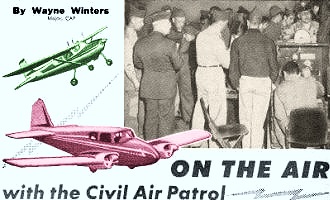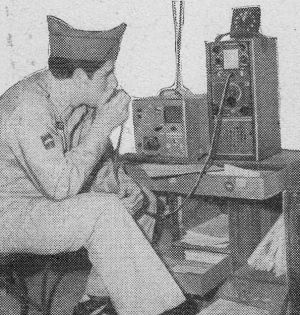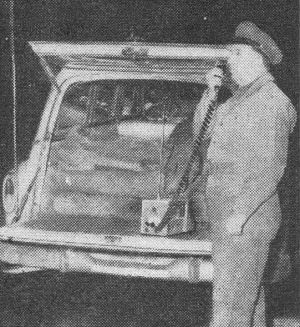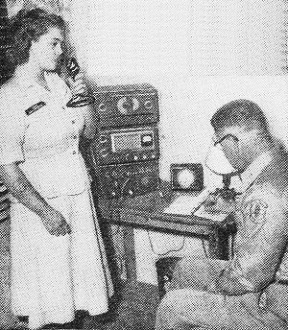March 1957 Popular Electronics
 Table
of Contents Table
of Contents
Wax nostalgic about and learn from the history of early electronics. See articles
from
Popular Electronics,
published October 1954 - April 1985. All copyrights are hereby acknowledged.
|
Back in the 1970s while taking
flying lessons, I used to enjoy watching the Civil Air Patrol run through its exercises
at Lee Airport, in Edgewater, Maryland. For some reason, I never bothered to look
into joining. I wish I had. A few years later while in Basic Training (BT) for the USAF
at Lackland AFB, Texas, there were a couple guys in my squadron who had been long-time
members of the CAP and guess what? They only had to spend the first two weeks in
BT, just long enough to do all the paperwork processing, take a few of the classroom
sessions, get shots, examinations, a head shave, and to have uniforms issued. Then,
immediately before leaving for technical school, they got to sew a stripe onto their
shirtsleeves as an Airman 1st Class. High school ROTC guys got to do the same thing.
I don't know if the Air Force still has that policy; you might want to check it
out if you're planning on joining.
On the Air with The Civil Air Patrol
 By Wayne Winters By Wayne WintersMajor, CAP
One evening last September a man slipped behind the wheel of his car in Albuquerque,
New Mexico, switched on a radio receiver and transmitter, and before he could back
out of the driveway was halted by the urgent call: "Thunderbird 39 to any Albuquerque
CAP station."
A quick reply to the Thunderbird (Arizona CAP station) operator brought no response,
so switching off the car, the Albuquerque Civil Air Patrol member beat a hasty retreat
to his house, fired up a 75-watt fixed station and, contacting Thunderbird 39, learned
that the Arizona operator was worried about a plane overdue in isolated Monument
Valley in the Navajo Indian reservation, where there are no phones for a hundred
miles.

Cadet operator works both high-frequency and very-high-frequency
portable rigs at a practice mission. At top of page, another operator is shown handling
traffic while numerous CAP personnel await further orders.

Control headquarters may be set up in any handy location to direct
search and rescue operations. The workshop of a communications officer was utilized
during a flood mission.

CAP member is talking into a lightweight v.h.f. packset
which he designed and built; his car is equipped with a high-frequency transmitter
and receiver.

A typical father and daughter team; Cadet Carrie Hopkins of Albuquerque
operates the radio while Lt. Col. Tom Hopkins makes a log entry. Anyone over 14
years of age can join the Civil Air Patrol ranks.
A check with Civil Aeronautics authorities in Albuquerque brought the disturbing
news that the pilot had left Albuquerque at 4 :02 that afternoon in a light plane,
estimating two hours en route to his Monument Valley destination and carrying four
hours of fuel aboard .... Now it was exactly 8 :00 p.m. The craft must be down somewhere
in the dark desert that would test a flyer's courage even in daylight.
Moments later, this disquieting information crackled back to Thunderbird 39,
and Albuquerque began preparations for an aerial search at dawn .... Yet an hour
later, even as alternate airfields were being checked, the Monument Valley station
came back on the air with the information that the pilot had landed at an emergency
field and walked over the desert to his destination. Plane and passengers were safe.
Two-way radio plays a big part in the Civil Air Patrol, the
organization which is charged with a large part of the search and rescue operations
for missing aircraft. Some 10,000 stations, operating on frequencies "loaned" by
the U. S. Air Force, are distributed over the 48 states, Hawaii, Alaska, District
of Columbia and Puerto Rico. By far the greater part of these stations are installed
in cars and trucks. Many "fixed" stations exist at airfields, CAP unit headquarters,
homes, and business offices. Not a few planes, either CAP-owned or private aircraft
belonging to members of the organization, are also equipped with two-way radios
operating on CAP frequencies. A number of walkie-talkie units are in the hands of
ground rescue teams and prove invaluable in search operations to provide communications
between aircraft flying cover, or to send information from a crash scene back to
a base camp.
The radio equipment used in CAP activities varies from station-to-station and
state-to-state. Some gear is supplied to the organization by the U. S. Air Force
after it has been declared surplus. Other equipment is purchased by the various
units from their own funds. Still more is the private property of individual members,
not a few of whom are also "ham" operators.
In most cases power limitations are fairly low. A maximum of 400 watts output
is provided for the one station in each state that is authorized to talk across
state borders, while the various other units are allowed either 150 or 75 watts
of power to the antenna. Most of the mobile units run from 10 to 50 watts, with
center-loaded antennas being most common.
Seven frequencies are authorized as follows: Channel One, 2374
kc.; Channel Two, 2394 kc. (Freehold and Fort Monmouth, .N. J., area only); Channel
Three, 4325 kc.; Channel Four, 4507.5 kc.; Channel Five, 4585 kc.; Channel Six,
5500 kc. (one watt only); Channel Seven, 148.14 mc. An eighth channel, which will
be in the v.h.f. band somewhere close to the amateur two-meter frequency, is planned.
Until the last three or four years, almost all CAP traffic was carried on the
high frequencies with Channels Four and Five predominating. Now the use of v.h.f.
Channel Seven is encouraged and an increasing number of stations have added v.h.f.
equipment to supplement the h.f. gear. This frequency is especially valuable where
short-range transmissions and air-to-ground communications are needed.
Civil Air Patrol transmitters must be crystal-controlled. Their operators must
hold restricted radiotelephone licenses or higher. The operation of the stations
must conform to all of the FCC regulations concerning frequency tolerances, type
of emission, etc. Accurate logs are required of each station's operation.
All Civil Air Patrol communications operations are carefully regulated. "Hamming"
is discouraged and an excessive amount of idle chatter is not tolerated. Regular
state-wide nets are scheduled at definite times each day during which traffic information
is passed from headquarters to local units and between individual stations.
In case of an actual mission or an emergency, talking between states is permissible
without the formality of using a state "control" station; but once such a mission
is definitely established, a "redcap" is declared and all transmissions are handled
through the control station. During the duration of a "redcap," all stations located
in nearby states which might cause interference with the communications either secure
or go to different channels.
Many CAP units, either Cadet or Senior squadrons, conduct courses
in radio communications under supervision of competent licensed personnel. Membership
is open to all persons 14 years of age or over. There is nothing compulsory about
the organization. While it is an auxiliary of the Air Force, there is no obligation
or arrangement for any Civil Air Patrol member or unit ever to be taken into the
armed forces as a result of his or her participation in the CAP program.
Although Civil Air Patrol radio communications is not connected with amateur
radio, many hams become CAP members and many CAP members develop an interest in
radio and become hams .... Neither activity conflicts with the other.
Many varied adventures reward the CAP volunteer. All too often, search and rescue
missions become necessary - several hundred a year. There are also practice missions,
Cadet encampments at Air Force bases, state and national meetings. Any man or woman
interested in radio Civil Air Patrol has a definite place to go to learn theory
and actual operating practice on the world's largest network of two-way radio stations.
Posted November 28, 2022
(updated from original
post on 10/25/2011)
|














